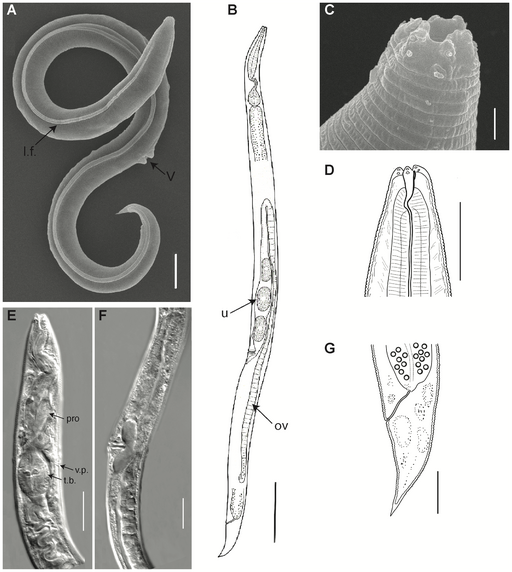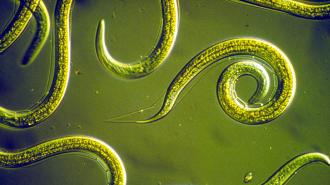A herd of wooly mammoths march across the snowy tundra steppe. Close by, human hunters scavenge meat from a dead elk with stone-flint tools while their compatriots scanned the horizon, wary that their kill might attract neighboring steppe lions. Against this ancient backdrop, something historic happened: A group of nematodes (also known as roundworms) became trapped and frozen in an arctic gopher burrow.
Granted, it didn’t seem all that historic at the moment. The nematodes are only about one millimeter long, so it’s unlikely even the gophers took notice. But one Ice Age later, Anastasia Shatilovich, a scientist working at the the Institute of Physicochemical and Biological Problems in Soil Science RAS, would unearth the burrow in the Siberian permafrost near the Kolyma River and discover something quite amazing. The nematodes were still alive.

Just add water for life
Radiocarbon dating of plant material found alongside the nematodes showed the specimens were frozen around the end of the Pleistocene epoch — sometime between 45,839 and 47,769 years ago. They managed to survive the intervening millennia thanks to a survival strategy known as cryptobiosis.
Cryptobiosis is a state some plant and animal species can undergo in response to overly harsh environmental conditions, such as freezing or extreme dryness. Essentially, the organism slows down biological functions to nearly undetectable levels to preserve itself. When environmental conditions return to livable, the organism revs up its metabolism and starts “living” again.
Perhaps the best-known cryptobiotic species is the tardigrade (also known as the water bear). This most extreme of extremo-tolerant animals can use cryptobiosis to survive freezing, high temperatures, and even exposure to outer space. For a more everyday example, you need only look to your cupboard. The fungal cells in active dry yeast have been desiccated to the point of entering cryptobiosis. When yeast and water combine as part of a recipe, the yeast returns to life (albeit shortly before being baked).
Even for cryptobiosis, the nematodes’ 46,000-year stint on ice is impressive. They handily beat the previous nematode record of 39 years and even the rotifer record of 24,000 years. It may ultimately prove to be the longest cryptobiotic hibernation — for an animal, that is. But it’s nowhere near the longest. Scientists were able to revive a bacterial spore from an extinct bee’s abdomen. The bee had been preserved in amber for 25 to 40 million years.
So, how did Shatilovich revive a pair of the prehistoric nematodes? Like all good bakers, she just added water and waited for life to rise.
Ancestor or contemporary?
The ancient nematodes would die several days later, as part of their natural life cycle, but not before spawning more than 100 generations of descendants. Shatilovich then took her discovery to researchers in Dresden and Cologne to have its DNA sequenced and morphology analyzed.
The researchers discovered that the nematodes belonged to the genus Panagrolaimus, a genus of nematodes that survives to this day. In fact, the Antarctic nematode Panagrolaimus davidi is known for its ability to survive in sub-zero temperatures. However, genome analysis showed that these nematodes belonged to a previously unknown species. The researchers named them Panagrolaimus kolymaensis, after the Kolyma River where they were discovered.
They also compared the genome to another contemporary species of nematode, Caenorhabditis elegans. Their analysis shows that both species prepare their bodies for cryptobiosis by upregulating a sugar, trehalose, which makes them more tolerant by protecting cellular membranes. They also discovered similar genes present in each species’ genomes.
However, they could not determine if those similar genes functioned the same way in both species or if P. kolymaensis had other biochemical pathways that helped it survive. In future studies, they hope to use RNA experiments to determine the species’ cryptobiosis mechanisms and determine if they are the result of convergence (the independent evolution of a similar trait in two unrelated organisms) or parallelism (the evolution of such a trait in a common ancestor).
“Our experimental findings also show that Caenorhabditis elegans can remain viable for longer periods in a suspended state than previously documented. Overall, our research demonstrates that nematodes have developed mechanisms that allow them to preserve life for geological time periods,” Temo Kurzhchalia, professor emeritus at the Max Planck Institute of Molecular Cell Biology and Genetics and one of the study’s authors, and Vamshidhar Gade, another study author, said in a news release.
The researchers published their findings in a study in the peer-reviewed journal PLOS Genetics.
Our findings are essential for understanding evolutionary processes because generation times can range from days to millennia.
Philipp Schiffer
Reconsidering the road of evolution
That life can be preserved across such periods of time further challenges a simplistic conception of evolution as a successive series of species, one progressing into the next. Consider, for example, the famous Road to Homo Sapians illustration: A chimp progresses into a bipedal primate into an upright primate into a tool-wielding primate into a modern human.
Cryptobiosis on a geologic scale complicates this simple idea of evolutionary processes. Prehistoric species — particularly microscopic ones like nematodes, bacteria, and viruses — may be out there alive and, well, not well but ready to reemerge. Ancestors might one day become contemporaries with their progeny, and as environments alter from climate change, previously unknown species may reappear. This makes the road to nematodes — and potentially other species — less a straight path and more an evolutionary highway system.
“Our findings are essential for understanding evolutionary processes because generation times can range from days to millennia and because the long-term survival of a species’ individuals can result in the re-emergence of lineages that would otherwise have gone extinct,” Philipp Schiffer, another study author and the co-lead of the Biodiversity Genomics Center at the University of Cologne, said in the same release.






